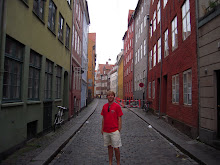But, as Isak relates, inter-personal relations are made up merely of discussions and evaluations of behavior and character. This introduction, which features Isak addressing himself for the audience, finds its pair in another instance of addressing the self. This quaint, warm and grandfatherly introduction comes in great contrast to the stark and terrifying nightmare sequence where Isak confronts a balloon faced version of himself—which promptly pops/dies—as well as a version of himself in a casket. Bergman skillfully employs non-diegetic music, including an ominous heartbeat when Isak roams the streets alone and some classic horror music when the presumably dead casket-Isak grabs the dream Isak and brings him closer. The final shot of the nightmare sequence is an intense, close up from Isak’s POV as casket Isak pulls him closer to him. This is not only a literal wake up call (the horror awakens Isak) but also a thematic one. This version of himself challenges the introductory one he provided the audience—Isak realizes that, if he continues to live his life in a state of withdrawal, he might end up like the Isak in the casket: knocked off the carriage and left only with his unconscious self.

So the film’s catalyst is evident: Isak needs to change. He is not fully sure how to effect change, but he starts by deciding to drive seven hours rather than fly on, career-wise, the most important day of his life. Isak senses that he needs to re-involve himself with the rest of humanity; maybe his interactions will prove his theory of people incorrectly. When his estranged daughter-on-law joins him on the road trip, it’s the first step in a journey that involves Isak revisiting his past and taking on the history behind his unhappiness. With each new piece of background knowledge—and each new passenger picked up along the way—Isak and the audience learn what has led to Isak’s dissatisfaction with human interaction, mainly that his brother stole the love of his life and his mother was unflinchingly control-driven.
These dips into the past, mainly occurring when Isak drives up to the home where his family used to spend his summers, are both pleasant and painful for Isak. He lights up when seeing his cousin Sara, the love of his life, but then suffers from serious loneliness and emptiness when he watches his brother snatch her away and Isak, ghost-like, hovering in the corner, watches the lunch table filled with his vibrant family members. Ultimately it seems, the pleasure of others outweighs the pain, as he relates to the local gas-station owner that “I wish I stayed here.” The film addresses the pain that is felt when addressing the past: Isak has another dream involving, presumably, a factual past event where he watches his wife, whom he doesn’t truly love or fight for, cheat with another man. But Isak’s past and his work bring him great pleasure, as evidenced at the ceremony. The road trip forces Isak to understand and get to know his daughter-in-law and the pressing issues she has with her husband, Isak's son Evald. Isak ultimately gets involved with the situation, speaking to Evald at the film’s close and relating his desire to move on and let go of grudges.

Though the film does end on too upbeat a note—as if all the negative past events are negated—the audience has witnessed a significant change in Isak. For pain and pleasure, Isak has successfully addressed himself, his hypocrisies, his faults, his wrongdoings, and has made a decided effort to change. Withdrawal, it seems, does more harm than good.

No comments:
Post a Comment